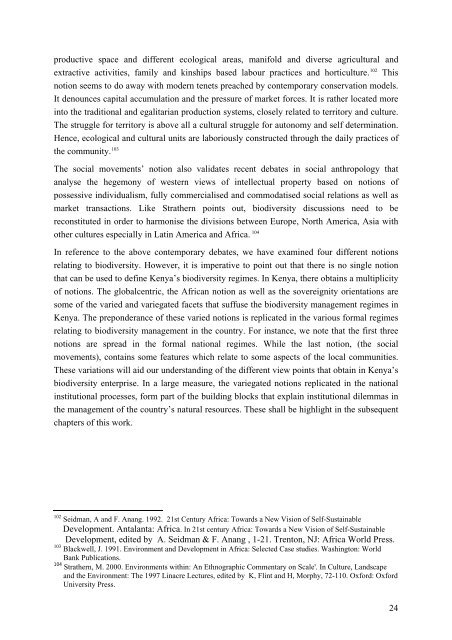THE UNIVERSITY OF LEIPZIG
THE UNIVERSITY OF LEIPZIG
THE UNIVERSITY OF LEIPZIG
Create successful ePaper yourself
Turn your PDF publications into a flip-book with our unique Google optimized e-Paper software.
productive space and different ecological areas, manifold and diverse agricultural and<br />
extractive activities, family and kinships based labour practices and horticulture. 102 This<br />
notion seems to do away with modern tenets preached by contemporary conservation models.<br />
It denounces capital accumulation and the pressure of market forces. It is rather located more<br />
into the traditional and egalitarian production systems, closely related to territory and culture.<br />
The struggle for territory is above all a cultural struggle for autonomy and self determination.<br />
Hence, ecological and cultural units are laboriously constructed through the daily practices of<br />
the community. 103<br />
The social movements’ notion also validates recent debates in social anthropology that<br />
analyse the hegemony of western views of intellectual property based on notions of<br />
possessive individualism, fully commercialised and commodatised social relations as well as<br />
market transactions. Like Strathern points out, biodiversity discussions need to be<br />
reconstituted in order to harmonise the divisions between Europe, North America, Asia with<br />
other cultures especially in Latin America and Africa. 104<br />
In reference to the above contemporary debates, we have examined four different notions<br />
relating to biodiversity. However, it is imperative to point out that there is no single notion<br />
that can be used to define Kenya’s biodiversity regimes. In Kenya, there obtains a multiplicity<br />
of notions. The globalcentric, the African notion as well as the sovereignity orientations are<br />
some of the varied and variegated facets that suffuse the biodiversity management regimes in<br />
Kenya. The preponderance of these varied notions is replicated in the various formal regimes<br />
relating to biodiversity management in the country. For instance, we note that the first three<br />
notions are spread in the formal national regimes. While the last notion, (the social<br />
movements), contains some features which relate to some aspects of the local communities.<br />
These variations will aid our understanding of the different view points that obtain in Kenya’s<br />
biodiversity enterprise. In a large measure, the variegated notions replicated in the national<br />
institutional processes, form part of the building blocks that explain institutional dilemmas in<br />
the management of the country’s natural resources. These shall be highlight in the subsequent<br />
chapters of this work.<br />
102<br />
Seidman, A and F. Anang. 1992. 21st Century Africa: Towards a New Vision of Self-Sustainable<br />
Development. Antalanta: Africa. In 21st century Africa: Towards a New Vision of Self-Sustainable<br />
Development, edited by A. Seidman & F. Anang , 1-21. Trenton, NJ: Africa World Press.<br />
103<br />
Blackwell, J. 1991. Environment and Development in Africa: Selected Case studies. Washington: World<br />
Bank Publications.<br />
104<br />
Strathern, M. 2000. Environments within: An Ethnographic Commentary on Scale'. In Culture, Landscape<br />
and the Environment: The 1997 Linacre Lectures, edited by K, Flint and H, Morphy, 72-110. Oxford: Oxford<br />
University Press.<br />
24






